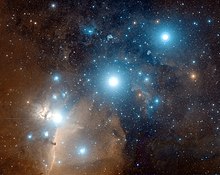Alnilam
| Observation data Epoch J2000 Equinox J2000 | |
|---|---|
| Constellation | Orion |
Pronunciation
|
/ælˈnaɪlæm/[1] |
| Right ascension | 05h 36m 12.8s[2] |
| Declination | −01° 12′ 06.9″[2] |
| Apparent magnitude (V) | 1.69[3] (1.64 – 1.74[4]) |
| Characteristics | |
| Spectral type | B0 Ia[5] |
| U−B color index | −1.03[3] |
| B−V color index | −0.18[3] |
| Variable type | α Cygni[4]
|
| Absolute magnitude (MV) | −6.89[7] |
| Details Myr | |
| Database references | |
| SIMBAD | data |
Alnilam is the central star of Orion's Belt in the equatorial constellation of Orion. It has the Bayer designation ε Orionis, which is Latinised to Epsilon Orionis and abbreviated Epsilon Ori or ε Ori. This is a massive, blue supergiant star some 2,000 light-years distant. It is estimated to be 832,000 times as luminous as the Sun, and 64.5 times as massive.
Observation

It is the 29th-brightest star in the sky (the fourth brightest in Orion) and is a blue supergiant. Together with Mintaka and Alnitak, the three stars make up Orion's Belt, known by many names across many ancient cultures. Alnilam is the middle star.
Since 1943, the
It is slightly variable from magnitude 1.64 to 1.74, with no clear period, and it is classified as an
Physical characteristics

Estimates of Alnilam's properties vary. Searle and colleagues, using CMFGEN code to analyse the spectrum in 2008, calculated a luminosity of 537,000 L☉, an effective temperature of 27,500 ± 100 K and a radius of 32.4 ± 0.75 R☉.[7] Analysis of the spectra and age of the members of the Orion OB1 association yields a mass 34.6 times that of the Sun (40.8 M☉ on the main sequence) and an age of 5.7 million years.[12] A more recent detailed analysis of Alnilam across multiple wavelength bands produced very high luminosity, radius, and mass estimates, assuming the distance of 606 parsecs suggested by the Hipparcos new reduction.[2] Adopting the larger parallax from the original Hipparcos reduction gives a distance of 412 parsecs[13] and physical parameters more consistent with earlier publications. The luminosity of 832,000 L☉ and the mass of 64.5 M☉ at 606 parsecs is the highest ever derived for this star.[9] A newer study from 2020 found smaller values for luminosity (420,000 L☉), radius (30.61 R☉), and mass (40 M☉).[8]
Alnilam's relatively simple spectrum has made it useful for studying the
Nomenclature and history
ε Orionis is the star's Bayer designation and 46 Orionis its Flamsteed designation.
The traditional name Alnilam derives from the
Orion's Belt
The three belt stars were collectively known by many names in many cultures. Arabic terms include Al Nijād ('the Belt'), Al Nasak ('the Line'), Al Alkāt ('the Golden Grains or Nuts') and, in modern Arabic, Al Mīzān al H•akk ('the Accurate Scale Beam'). In Chinese mythology, they were also known as the Weighing Beam.[16]
In
See also
References
- ISBN 978-1-931559-44-7.
- ^ S2CID 18759600.
- ^ Bibcode:2002yCat.2237....0D.
- ^ S2CID 121747360.
- ^ S2CID 4109100.
- S2CID 119231169.
- ^ S2CID 1552752.
- ^ ISSN 0004-6361
- ^ S2CID 7887625.
- ^ "GCVS Query forms". www.sai.msu.su. Retrieved 2019-01-12.
- S2CID 119388848. Retrieved 11 August 2022.
- S2CID 38599952. A51.
- Bibcode:1997A&A...323L..49P.
- ISSN 0004-6256.
- S2CID 18815761.
- ^ a b Allen, Richard Hinckley (1936). Star-names and their meanings. pp. 314–315.
- Bibcode:1909Obs....32..357K.
- ^ "IAU Working Group on Star Names (WGSN)". Retrieved 22 May 2016.
- ^ "Bulletin of the IAU Working Group on Star Names, No. 1" (PDF). Retrieved 28 July 2016.
- ^ "IAU Catalog of Star Names". Retrieved 28 July 2016.
- ISBN 978-986-7332-25-7.
- ^ (in Chinese) AEEA (Activities of Exhibition and Education in Astronomy) 天文教育資訊網 2006 年 5 月 25 日

